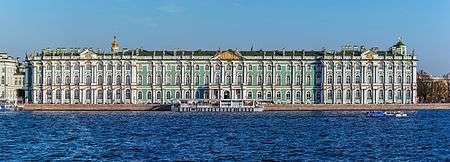Hermitage Bridge
| Hermitage Bridge Russian: Эрмитажный мост | |
|---|---|
|
Bridge view from Neva river | |
| Coordinates | 59°56′34″N 30°19′01″E / 59.94268°N 30.31683°ECoordinates: 59°56′34″N 30°19′01″E / 59.94268°N 30.31683°E |
| Carries | traffic and pedestrian |
| Crosses | Winter Canal |
| Locale | Saint Petersburg |
| Characteristics | |
| Design | Arch Bridge |
| Total length | 22.1 m |
| Width | 15.2 m |
| History | |
| Opened | 1720 (wooden), 1766 |
The Hermitage Bridge (Russian: Эрмита́жный мост) is a bridge across the Winter Canal along Palace Embankment in Saint Petersburg, Russia. The bridge constitutes part of the Hermitage and Winter Palace ensemble.
Ground location
The bridge is between buildings Hermitage theatre (32, Palace Embankment) and Old Hermitage (34, Palace Embankment). Winter Canal through which will throw this bridge, proceeds between two islands: Winter Palace is on second Admiralty island (in the west), Hermitage theatre – on first Admiralty island (in the east). Automobile movement on the bridge dense, is carried out on two strips – on one in each party. Channel waters under the bridge flow in a direction from Neva to Moyka, movement of courts on the channel unilateral – from Moyka to Neva.
The nearest station of the Saint Petersburg Metro – "Admiralteyskaya", an exit on Griboyedov Canal (1.2 km).

History
The original bridge was a three-span wooden drawbridge constructed in 1718–20 by Herman van Boles, immediately after the canal near the Winter Palace was completed. This bridge was narrow, allowing passage of only one cart at a time.
The permanent stone bridge was built in 1763–66, in conjunction with building of granite embankments of the Neva River. Today, Hermitage Bridge remains the oldest stone bridge in Saint Petersburg.[1]
Originally the arch of the bridge was built from brick and limestone with granite exterior. In 1934 it was replaced with the new monolithic hinge-free ferroconcrete arch, but the granite facade was preserved by the project of engineer A. D. Sapestein and architect K. M. Dmitriev, the adviser – professor G. P. Peredery.[2] In 1950, the original decor of ramps was restored.
Name
| Winter Canal | ||||||||||||||||||||||||||||||||||||||||||||||||||||||||||||||||
|---|---|---|---|---|---|---|---|---|---|---|---|---|---|---|---|---|---|---|---|---|---|---|---|---|---|---|---|---|---|---|---|---|---|---|---|---|---|---|---|---|---|---|---|---|---|---|---|---|---|---|---|---|---|---|---|---|---|---|---|---|---|---|---|---|
Legend
| ||||||||||||||||||||||||||||||||||||||||||||||||||||||||||||||||
On 20 April 1738, the bridge received its first official name of Upper Embankment Bridge (Russian: Верхний Набережный мост) after the Upper Embankment street (today's Palace Embankment). However, this name didn't catch on. The name Winter Palace Bridge (Russian: Зимнедворцовый мост) after the nearby Winter Palace started to circulate in the middle of the 18th century. From the end of the 18th century the bridge was renamed to Palace Bridge (not to be confused with the modern Palace Bridge). The current name was established in 1929. The Hermitage Bridge name came from the Hermitage Theater which was built by that time between Winter Canal and Winter Palace.[3]
References
- ↑ Бунин М. С. (1986). Мосты Ленинграда. Saint Petersburg. pp. 158–61.
- ↑ "Hermitage Bridge". Retrieved 2008-08-19.
- ↑ ЭРМИТАЖНЫЙ МОСТ (in Russian). Retrieved 2008-08-19.
